Related Research Articles
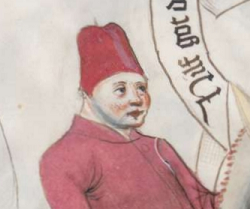
Paulus Kal was a 15th-century German fencing master. According to his own testimony, he was the student of one Hans Stettner, who was in turn an initiate of the tradition of Johannes Liechtenauer. He served as fencing master at three different courts in his career, serving in various military capacities including commanding men in at least three campaigns. Perhaps his most significant legacy is an honor role of deceased masters included in the Bologna and Munich versions of his treatise, which he styled the Society of Liechtenauer. While several of these masters remain unknown, the majority wrote treatises of their own and Kal's list stands as an independent confirmation of their connection to the grand master. Kal's treatise is also interesting in that it represents the first attempt to give pictorial illustrations for parts of Liechtenauer's tradition of fencing.
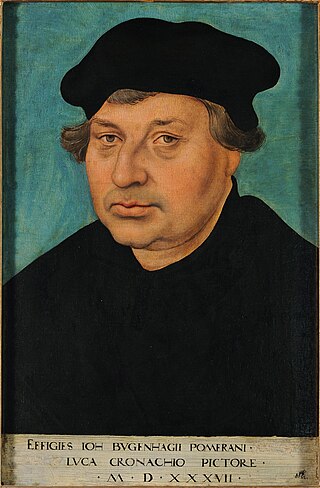
Johannes Bugenhagen, also called Doctor Pomeranus by Martin Luther, was a German theologian and Lutheran priest who introduced the Protestant Reformation in the Duchy of Pomerania and Denmark in the 16th century. Among his major accomplishments was organization of Lutheran churches in Northern Germany and Scandinavia. He has also been called the "Second Apostle of the North".
A chantry is an ecclesiastical term that may have either of two related meanings:
- a chantry service, a Christian liturgy of prayers for the dead, which historically was an obiit, or
- a chantry chapel, a building on private land, or an area in a parish church or cathedral reserved for the performance of the "chantry duties".
Heiko Augustinus Oberman (1930–2001) was a Dutch historian and theologian who specialized in the study of the Reformation.
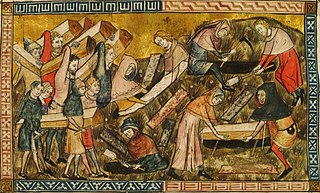
The Crisis of the Late Middle Ages was a series of events in the fourteenth and fifteenth centuries that ended centuries of European stability during the Late Middle Ages. Three major crises led to radical changes in all areas of society: demographic collapse, political instability, and religious upheavals.

Blaubeuren Abbey was a Benedictine monastery until the Reformation, located in Blaubeuren, Baden-Württemberg, Germany. It is now a Protestant seminary.
New High German is the term used for the most recent period in the history of the German language, starting in the 17th century. It is a loan translation of the German Neuhochdeutsch. The most important characteristic of the period is the development of a standard written German, followed by the standardisation of the spoken language. For this reason, the term New High German is also used as a synonym for modern standard German.

The Abbey of Saint Victor, Paris, also known as Royal Abbey and School of Saint Victor, was an abbey near Paris, France. Its origins are connected to the decision of William of Champeaux, the Archdeacon of Paris, to retire to a small hermitage near Paris in 1108. He took on the life, vocation and observances of the Canons Regular, and his new community followed the Augustinian Rule.
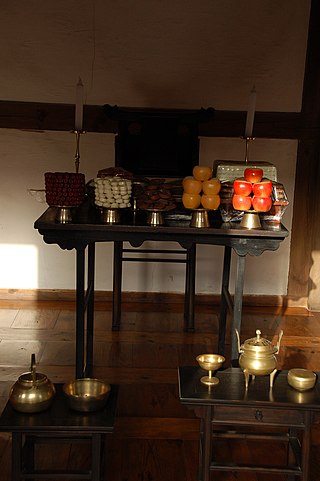
A death anniversary is the anniversary of the death of a person. It is the opposite of birthday. It is a custom in several Asian cultures, including Azerbaijan, Armenia, Cambodia, China, Georgia, Hong Kong, Taiwan, India, Myanmar, Iran, Israel, Japan, Bangladesh, Korea, Nepal, Pakistan, the Philippines, Russia, Sri Lanka and Vietnam, as well as in other places with significant overseas Chinese, Japanese, Jewish, Korean, and Vietnamese populations, to observe the anniversary on which a family member or other significant individual died. There are also similar memorial services that are held at different intervals, such as every week.
Jeffrey F. Hamburger is an American art historian specializing in medieval religious art and illuminated manuscripts. In 2000 he joined the faculty of Harvard University, where in 2008 he was appointed the Kuno Francke Professor of German Art and Culture. Hamburger received his B.A., M.A and Ph.D from Yale and has previously held professorships at Oberlin College and the University of Toronto. Elected a Fellow of the Medieval Academy in 2001, he has won numerous awards for his publications, among them: the Charles Rufus Morey Prize of the College Art Association (1999), the Roland H. Bainton Book Prize in Art & Music (1999), the Otto Gründler Prize of the International Congress on Medieval Studies (1999), the Jacques Barzun Prize in Cultural History of the American Philosophical Society (1998), the John Nicholas Brown Prize of the Medieval Academy of America (1994), and the Gustave O. Arlt Award in the Humanities of the American Council of Graduate Schools (1991). His research has been supported by fellowships from the Guggenheim Foundation, the American Philosophical Society, the Institute for Advanced Study, the National Endowment for the Humanities, the Center for Advanced Study in the Visual Arts, and the Alexander von Humboldt Foundation. In 2009 Hamburger was elected a member of the American Academy of Arts and Sciences and in 2010, of the American Philosophical Society. In 2015 he was awarded an Anneliese Maier Research Award by the Alexander von Humboldt Foundation. In 2022 he was awarded the Gutenberg Prize of the City of Mainz and the Internationale Gutenberg-Gesellschaft.

Europa regina, Latin for Queen Europe, is the map-like depiction of the European continent as a queen. Made popular in the 16th century, the map shows Europe as a young and graceful woman wearing imperial regalia. The Iberian peninsula (Hispania) is the head, wearing a crown shaped like the Carolingian hoop crown. The Pyrenees, forming the neck, separate the Iberian peninsula from France (Gallia), which makes up the upper chest. The Holy Roman Empire is the centre of the torso, with Bohemia being the heart of the woman. Her long gown stretches to Hungary, Poland, Lithuania, Livonia, Bulgaria, Muscovy, Macedonia and Greece. In her arms, formed by Italy and Denmark, she holds a sceptre and an orb (Sicily). In most depictions, Africa, Asia and the Scandinavian peninsula are partially shown, as are the British Isles, in schematic form.
Bernd Moeller was a German Protestant theologian and church historian.

Saint Mary's Cathedral in Hamburg was the cathedral of the ancient Roman Catholic Archdiocese of Hamburg, which was merged in personal union with the Diocese of Bremen in 847, and later in real union to form the Archdiocese of Hamburg-Bremen, as of 1027.

Philip Benedict is an American historian of the Protestant Reformation in Europe, currently holding the title of Professor Emeritus at the University of Geneva’s Institute for Reformation History.
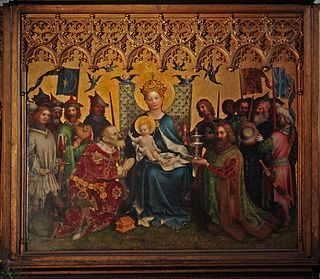
The term Cologne School of Painting was first applied in the 19th century to describe old German paintings generally. It subsequently came to refer more specifically to painters who had their workshops in medieval Cologne and the lower-Rhine region from about 1300 to 1550.

The Cross of Otto and Mathilde, Otto-Mathilda Cross, or First Cross of Mathilde is a medieval crux gemmata processional cross in the Essen Cathedral Treasury. It was created in the late tenth century and was used on high holidays until recently. It is named after the two persons who appear on the enamel plaque below Christ: Otto I, Duke of Swabia and Bavaria and his sister, Mathilde, the abbess of the Essen Abbey. They were grandchildren of the emperor Otto I and favourites of their uncle, Otto II. The cross is one of the items which demonstrate the very close relationship between the Liudolfing royal house and Essen Abbey. Mathilde became Abbess of Essen in 973 and her brother died in 982, so the cross is assumed to have been made between those dates, or a year or two later if it had a memorial function for Otto. Like other objects in Essen made under the patronage of Mathilde, the location of the goldsmith's workshop is uncertain, but as well as Essen itself, Cologne has often been suggested, and the enamel plaque may have been made separately in Trier.

Matthias Martin Tischler is a German palaeographer, philologist and historian, stemming from a multinational and -confessional family with Austrian, Bohemian, French and Hungarian origins. He is married to the Catalan philologist and linguist Eulàlia Vernet i Pons and lives with his family in L'Ametlla del Vallès, Barcelona and Münchberg.

Michael Borgolte is a German Historian. Besides the history of medieval endowments he studies mainly the Comparative history of Europe and the Global history of the Middle Ages.
Ute Lotz-Heumann is a German-American historian specializing in early modern Irish and German history and the history of the European Reformations and Enlightenment. She is the Heiko A. Oberman Professor of Late Medieval and Reformation History at the University of Arizona in Tucson, Arizona.
Thomas Wünsch is a German historian.
References
- ↑ Michael Borgolte, Foundations 'For the Salvation of the Soul' - an Exception in World History?, in: Medieval Worlds, vol. 1, 2015 pp. 87-105.
- ↑ Rainer Hugener, The Social. Ritual, Faith, Practices, and the Everyday, in: Stefan Berger, Jeffrey K. Olick (eds.): Bloomsbury Cultural History of Memory, vol. 2: A Cultural History of Memory in the Middle Ages, ed. Gerald Schwedler, London/New York 2020, pp. 123-146, ISBN 978-1-4742-7338-1; Peter-Johannes Schuler: Das Anniversar. Zu Mentalität und Familienbewusstsein im Spätmittelalter, in: id. (ed.): Die Familie als sozialer und historischer Verband. Untersuchungen zum Spätmittelalter und zur frühen Neuzeit, Sigmaringen 1987, pp. 67-117 ISBN 9783799558112.
- ↑ Leo Koep, Das himmlische Buch in Antike und Christentum: Eine religionsgeschichtliche Untersuchung zur altchristlichen Bildersprache, Bonn 1952.
- ↑ Rainer Hugener, Buchführung für die Ewigkeit: Totengedenken, Verschriftlichung und Traditionsbildung im Spätmittelalter. Zürich 2014, pp. 31-2, ISBN 978-3-0340-1196-9 (PDF).
- ↑ For England cf. Peter Marshall, Beliefs and the Dead in Reformation England, Oxford 2000, pp. 94-5, ISBN 978-0198207733.
- ↑ Jean-Loup Lemaître, Répertoire des documents nécrologiques français, Paris 1980 (Recueil des historiens de la France publié par l’Académie des inscriptions et belles-lettres. Obituaires), ISBN 978-2-87754-401-6.
- ↑ Hugener (2014), pp. 303-91.